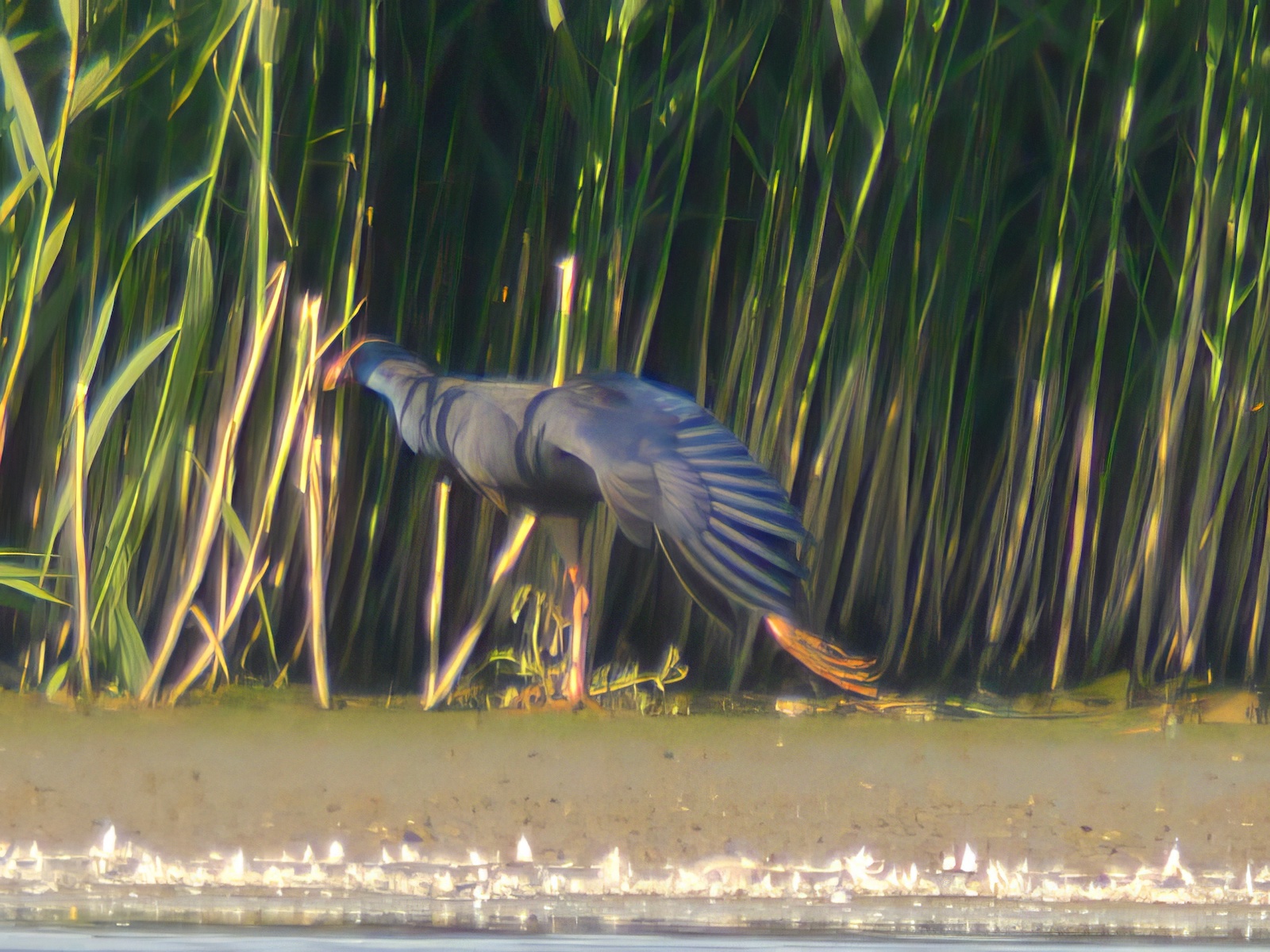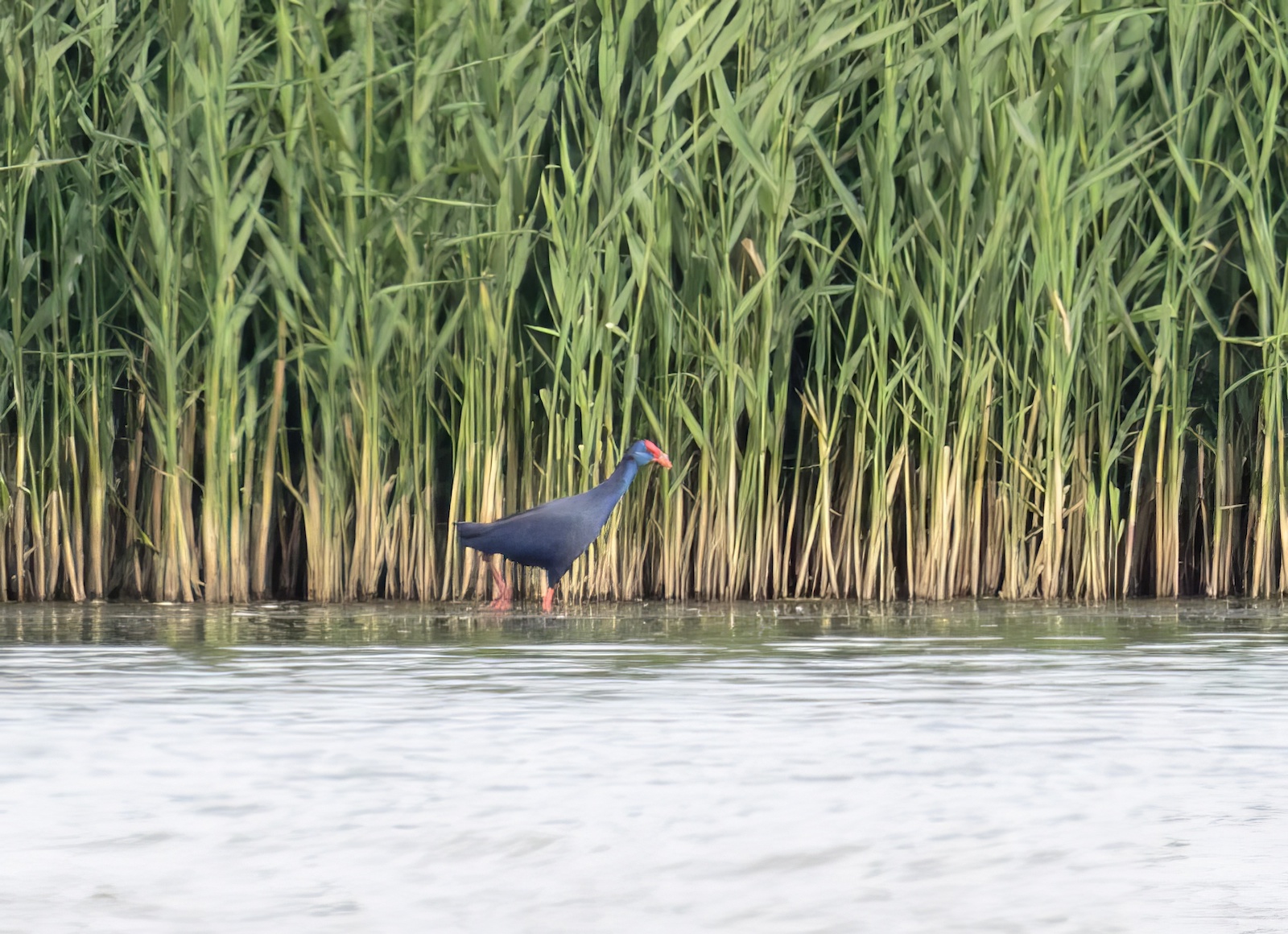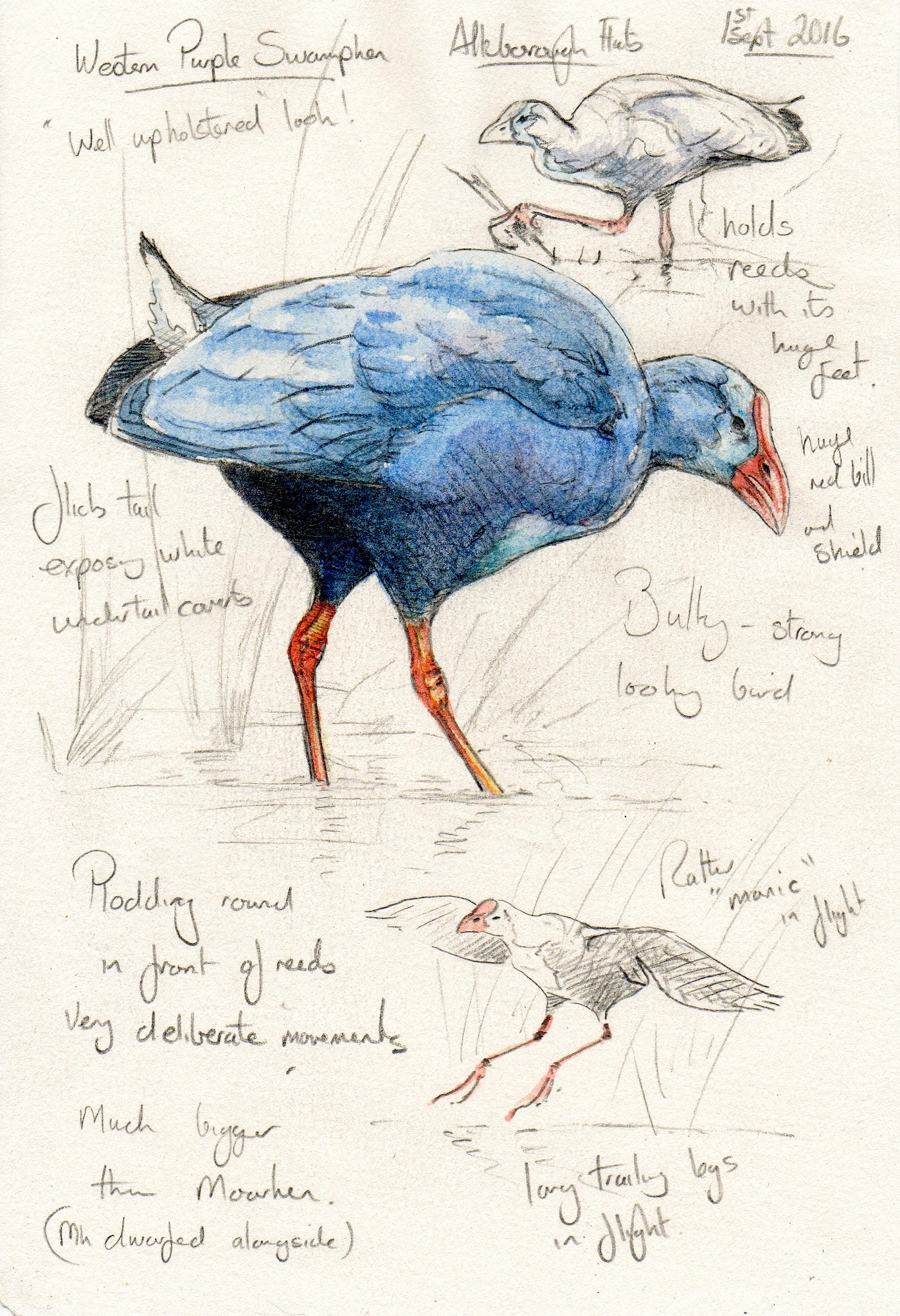Western Swamphen Porphyrio porphyrio
Vagrant. Southern Europe.


Western Swamphen Alkborough Flats left, August 30th 2016 (Russell Hayes) and right, September 4th 2016 (Graham Catley)

Western Swamphen sketches courtesy of Steph Thorpe September 1st 2016.
A Western Swamphen was found on a reed-fringed pool at Minsmere, Suffolk on July 31st, 2016 where it remained until August 5th. This was the first occasion on which this species has been recorded in Britain. Incredibly what was thought to be the same bird was then found in Lincolnshire at Alkborough Flats on August 31st-November 23rd 2016 and again briefly on January 4th, 2017.
The species had been declining in the Mediterranean and a reintroduction scheme began in Spain in the 1980s and as numbers increased the species spread into France where it first bred in 1996. Despite a setback after severe weather in February 2012 numbers recovered and in 2016 there were a number of sightings in central and northern France. One found at Deux-Sèvres on Jul 19th was only c.300km due south of Minsmere, could this have been the same bird?
| Site | First date | Last date | Count | Notes |
| Alkborough Flats | 30/08/2016 | 23/11/2016 | 1 | Adult |
| Alkborough Flats | 04/01/2017 | 1 | Same adult |
Finder's report: Western Swamphen at Alkborough Flats, August 30th 2016, first county record.
by Graham P Catley.
Note: this account appeared in the Lincolnshire Bird Report for 2016. The BBRC report for 2016 noted that the ‘Purple Swamphen’ complex was split into six species in July 2015 by the IOC, three of which could potentially reach the UK: Western Swamphen, which breeds in southwest Europe and northwest Africa; Grey-headed Swamphen P. poliocephalus from the Middle East, Indian subcontinent and Southeast Asia; and African Swamphen P. madagascariensis from Egypt, sub-Saharan Africa and Madagascar.
Circumstances
On a very hot and sunny August 30th a number of observers including P. Cleford and little Sid noticed a large purple bird walking about on the mud opposite the first hide and news quickly disseminated via the usual birding channels that a Western Swamphen was at Alkborough Flats. It was far too hot to be out birding so I was at home working when the phone started going off; first Lee Evans then Neil Drinkall asking what I knew of the reported Swamphen at Alkborough Flats. Clearly the answer was nothing but within 30 minutes I was in the hide with a few hopefuls and looking at an image on the back of someone’s camera.
Since the managed realignment site was first flooded in 2006 Neil Drinkall has spent thousands of hours at the site and GPC a few thousand and between the two of us we had found most of the rare birds seen in that ten year period but the really big rarity had always eluded us. On the evening of August 29th ND had been in the hide until 20:00 and had seen nothing of note. Sitting down to wait in the sauna of the hide it still seemed incredible that after a combined 20 years of watching the site the two of us had missed out on the really big find by a few hours but that’s bird finding. After about a 20-minute wait the 'swamp donkey' emerged from its favoured patch of phragmites and scope views confirmed that it was indeed a western Swamphen and not one of the other eastern races. It then proceeded to walk about eating phragmites rhizomes in typical foot to bill manner. I took some distant photos in the heat to confirm the birds identification. On the evening of the 30th Kev Wilson and Nige Lound saw the bird fly from its favoured area to the north-western part of the inundation area and land in an area of reeds that is not visible from the hide.
The following day it could not be found and I spent most of the day looking around other parts of the site but failed to see it then on September 1st Clare Gillatt was in the hide when the Swamphen appeared in the same location opposite the hide. From then on it developed a habit of moving to an enclosed area of open water within the main reedbed and spending most of its time in there but occasionally returning to the site opposite the hide mainly on spring tides when the site was flooded. It was never closer than 250m and when on the enclosed water area it was only visible from the adjacent hillside 800m away proving particularly difficult to see even from the adjacent escarpment and proving the value of having a 70x scope!. Observations then continued daily until early November albeit with the bird being seen for increasingly shorter periods and many observers making repeat visits in order to obtain brief and distant views. The bird was not seen for over a week in mid-November but I picked it up again in the same location on November 23rd and this proved to be what we assumed was the last observation of the bird as regular searches by ND and GPC failed to reveal any sign of the bird. Then on January 4th 2017 GPC was undertaking a regular wintering bird survey count from the Maze at Julian’s Bower when the Swamphen appeared out in the open at the back of the inundation area where it had never been seen before. After a couple of minutes it disappeared in the reeds again and in spite of regular searches from then onwards it was never seen again.
Description
A large gallinule over twice the size of the adjacent Moorhen; plumage all blue with purple sheen in good light; bill large conical and bright pink; extensive frontal shield over fore-crown also bright reddish pink; legs and feet same bright reddish pink. Head and fore neck brighter blue than the rest of the body plumage and wing coverts also brighter marine blue than body and flight feathers; undertail coverts contrastingly bright white. Flew with ease, trailing feet and legs, keeping low over the reeds. No calls were heard. Its general behaviour involved walking around the edges of the reedbed pulling reed rhizomes from the mud then holding them in its large toes while stripping them in its bill before consuming the inner parts. It had a missing or part grown inner secondary on the left wing apparently in the same position as the Minsmere bird see paragraph below.
Even the name Western Swamphen may be unfamiliar to most people who are not involved in the taxonomy of birds for the bird formerly known as Purple Gallinule and then Purple Swamphen is now widely being promoted to a full species the Western Swamphen, differing from other former subspecies that occur eastwards to Australia and New Zealand and south to southernmost Africa, mainly in back and head colour. The Western Swamphen breeds in southern Europe with the bulk of the population in southern Spain and recently in southern France. Until July 31st 2016 there had never been a Western Swamphen in Britain so when a bird arrived at Minsmere in Suffolk it caused something of a stir in the birding world as there seemed to be good support for the bird being of wild origin rather than an escapee from a wildlife park. The bird was unringed with no obvious signs of feather wear; recent droughts in southern Spain in summer have seen birds moving away from their desiccated habitats and other birds had been reported well to the north in France in summer 2016. The Minsmere bird was seen on August 5th but not thereafter denying many would be watchers of the chance to see this species in Britain. Alkborough Flats to the rescue as the bird from August 30th remained into mid-November albeit giving rather distant and often brief views that tested the quality of peoples’ optical gear, and last being seen on November 23rd. An adult in the same plumage as the Minsmere bird the question on everyone’s mind was, is it the same bird? The answer would appear to be 'yes' as both birds had a part grown outer secondary feather on the left wing surely too much of coincidence to mean there have been two birds involved. The distance from Minsmere in a direct line is 225kms in a NNW direction but where was the bird between August 6th-30th?
After giving poor views and being particularly elusive on September 3rd a planned visit by Mike Dilger and a team from the BBC’s One Show on the 4th seemed doomed to fail but amazingly the bird was back in front of the hide at dawn and the cameraman was able to obtain some excellent footage of the bird that duly appeared on the BBC later in the year.
The record was accepted by BBRC (British Birds 110(10): 562-631) and Western Swamphen was duly admitted to the British List by the BOURC, and of course to the Lincolnshire List!.
(Account as per new Birds of Lincolnshire (2021), included September 2022)

